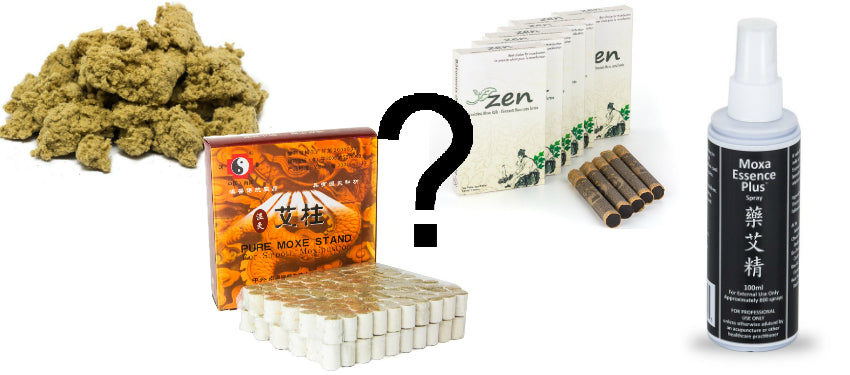Nowadays, there are various kinds of moxibustion products(moxa) available on the market: from the familiar stick moxa to needle moxa, from loose moxa and smokeless moxa to even moxa sprays, the number of choices can sometimes be overwhelming. This article will help you understand moxa production better, and in turn to understand how to tell a good product from an inferior one, and to finally make an informed decision about which ones to use in your practice.
Moxibustion products are all made from Chinese mugwort (Ai). Mugwort leaves are used to make loose moxa, which can then be made into stick moxa and finally into needle moxa. During this process, different products are produced at every stage of production. In order to guarantee the quality and therefore effectiveness of moxa products, the careful regulation of raw materials and of the production process becomes of paramount importance. Several principles that may seem arcane or even obscure to outsiders are enshrined in moxa productions, and they collectively ensure consistency and quality. Loose Moxa As discussed in another blog post-Differences between Chinese mugwort (Qi mugwort) and others. Qi Mugwort is the best raw material, yielding the highest quality loose moxa. Its leaves are large and thick, with a lot of downy, fine hair on back of the leaves. Lierre chooses to use the best quality Qi mugwort leaves for our moxa products. Picking the best mugwort leaves from all growing leaves is a difficult task. The Chinese dragon boat festival is widely considered to be the best time to pick mugwort leaves, as it grows best during this period. It is the fifth day of fifth lunar month of the year. Experienced mugwort leaves picker favour leaves shaped like the human body. Another common selection method is to push down all the mugwort several days before picking leaves. Several days later, pickers will only choose the mugwort leaves that stand up again, because they have proven that they grow better than others.
The next and arguably most important step is to make loose moxa from these leaves. In ancient times, producers would produce it by hand, by first mixing leaves with plant ash and water. They would then mould the mixture into a round plate shape, then sundry and store it. The fully dried product is set on a mixture plate, rubbed repeatedly, and the ashes are filtered out. This last process is repeated until the loose mugwort is free from impurities, which can compromise its quality. This process now is now fully automated: as a result, the filtering process is much faster and more thorough than the traditional manual way. Though the resulting loose mugwort is close to moxa, it is not usable at this stage. In order to reach its full therapeutic potential, it must be stored and aged for a long period of time, most commonly three years. Higher quality loose moxa is stored for five years, and usually appropriately labelled. Among other benefits of aging, the oil on the mugwort leaves evaporates during this process. This four step process of transformation yields the best quality loose moxa. It is totally different from un-aged, inferior quality moxa in five respects: color, texture, smell, smoke and fire.
Color: Good quality moxa has a golden hue due to the aging process, and new moxa has a greenish color. Texture: Loose moxa made with good mugwort leaves feels cottony to the touch. They are solid, soft, with some elasticity, but not fluffy. Moxa made with the branches and stems of mugwort tends to be very stiff. They are not as good as loose moxa made with mugwort leaves. Scent: Good quality moxa smells very mild, whereas new moxa has a distinct grassy smell, which comes from the mugwort oil. Smoke: Aged, high quality moxa produces white smoke with mild scent, but inferior quality moxa can have a strong, pungent smell which is not good. Fire: The fire of good quality aged moxa is mild, allowing treatments to last longer and avoiding possibly discomfort and injuries. Due to its usually higher oil content, poor quality moxa will burn fast and very hot, making treatments difficult and potentially dangerous. Here is the comparison of different quality moxa. The left one does not use the mugwort leaves, instead it uses stem and branches. The middle one does not aged enough time and there are lots of impurities. The right one uses mugwort leaves and aged over 3 years. The color is golden and contains less impurities. Lierre has the smoke moxa products similar to the right one which has golden color with high purity level.
Lierre only chooses the best moxa aged for over 3 years for our customers to purchase. Stick and Needle Moxa At this point in the process, then, the loose moxa can be made into stick moxa.
At first glance, it might seem as easy as rolling loose moxa into paper; however, the sticks are so solid that they keep their shape even when they’re unwrapped. Loose moxa has to be extremely compressed to achieve this state, and applying the required pressure is the most challenging part of the process. If a stick falls apart, it’s a sure sign that the moxa sticks are of inferior quality. Needle moxa, then, is simply stick moxa cut into smaller pieces then attached to a needle support. If the stick moxa crumbled easily, it would be impossible to make effective needle moxa! To be continued... Apart from a professional moxibustion supplier in Canada, we are also supplying the best quality acupuncture needles, massage tables, massage accessories, personal care products, massage supplies, and more at great prices. You can find out more great products at www.lierre.ca All rights reserved for Lierre Blog.



